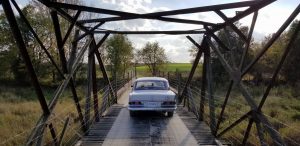“This is one of the most unusual bridges in Ontario and perhaps beyond. It is a bridge pieced together, seemingly randomly without concern for engineering of any kind, from salvaged steel of riveted construction. The bridge consists of two through girder spans at the southern end, and two through truss spans at the northern end. It would be hard to call this a “heritage bridge” yet it is composed of old materials, and is a truly unique structure. It no doubt instills great fear into any engineer.
The girder spans are composed of rolled girders with riveted connections for various beams, most of which were removed when the girders were salvaged. The composition is truly extraordinary. Each girder in the span is itself composed of two girders (of differing size and design) which are crudely welded together from pits of plate at midspan. Moreover, in each span, the girder design/size does not always match the design on the opposite side of the road!
The two truss spans are no less remarkable. It would appear that these truss spans are composed from salvaged roof trusses. The roof trusses are of all-riveted construction, but they were welded together to assemble the truss bridge. Because of the haphazard way in which these trusses were pieced together to form the bridge span, these trusses do not conform to any known truss configuration.
The origin and ownership of the bridge is unknown. Although no signage forbids usage, there is a “dead end” sign that appears next to the last driveway before the bridge, suggesting that public/government ownership ends at this point. Beyond the dead end road sign, the road and bridge might not be owned by the government. The local Mennonite community has been known to build low-budget crossings (the most famous is a nearby concrete low water crossing called the Mennonite Bridge). It is possible that they built and maintain this bridge.”
historicbridges.org
